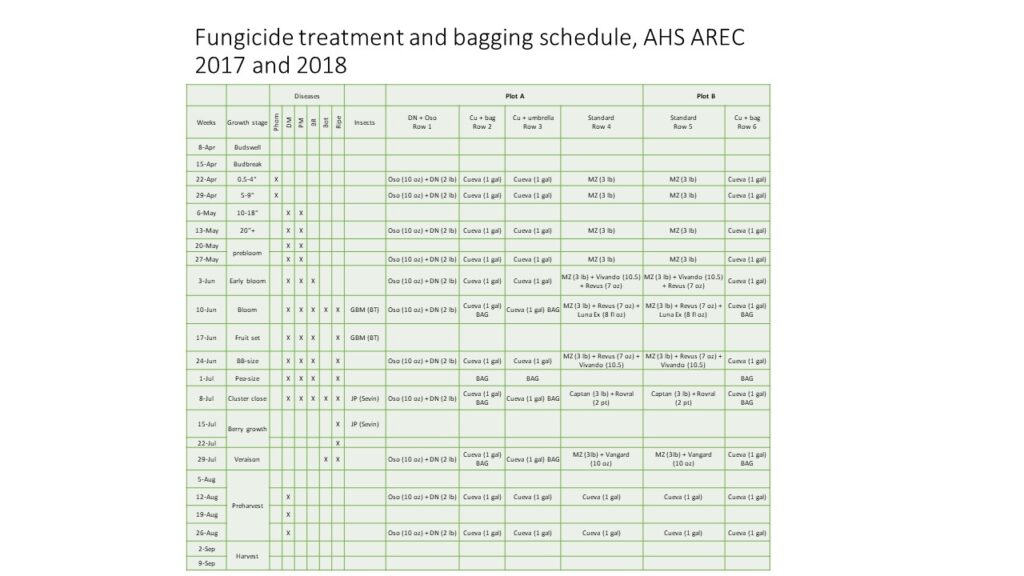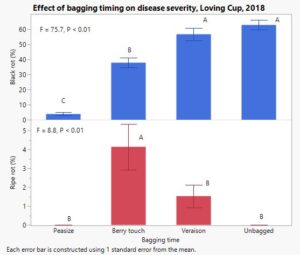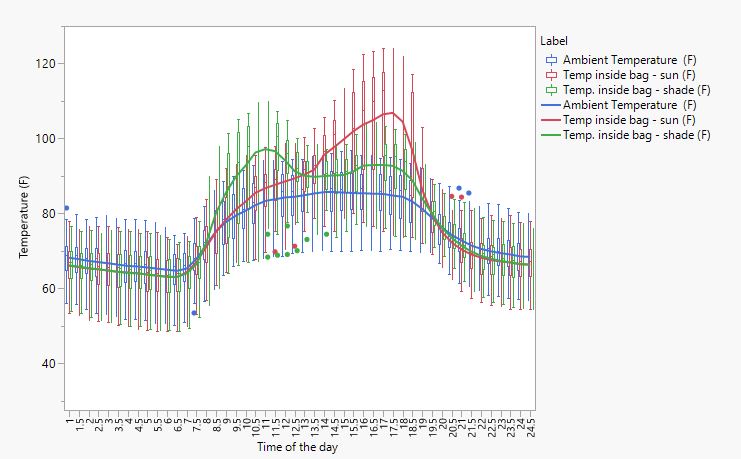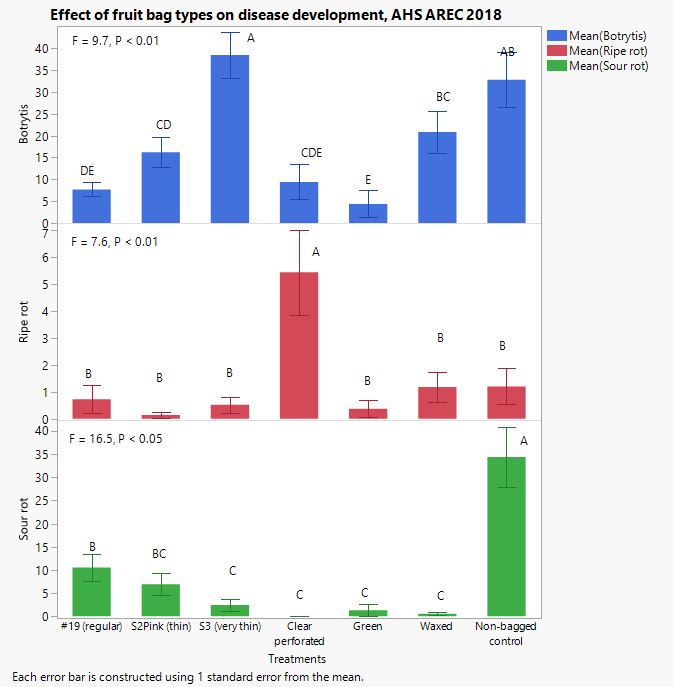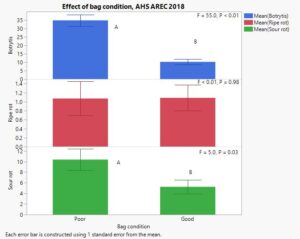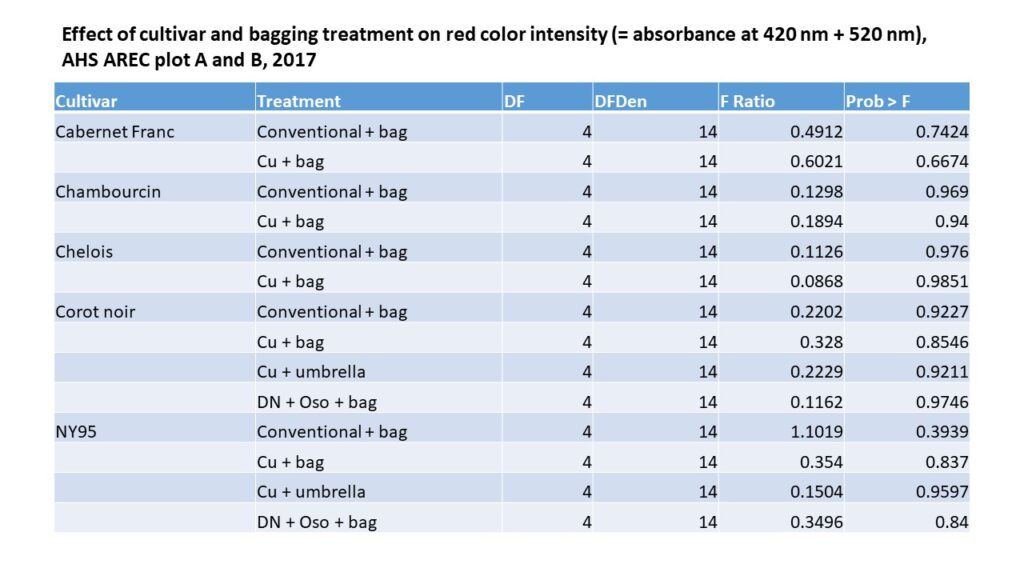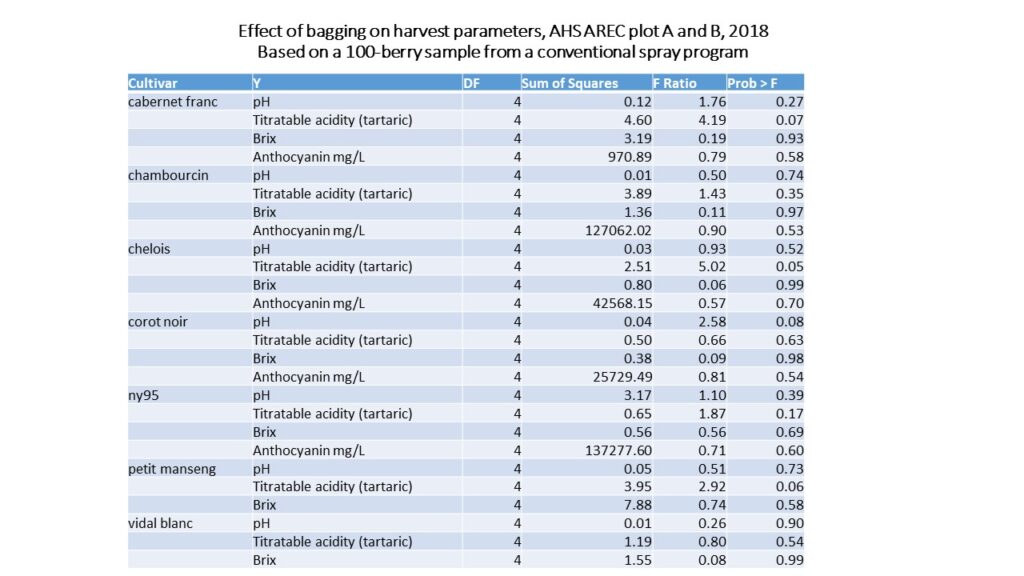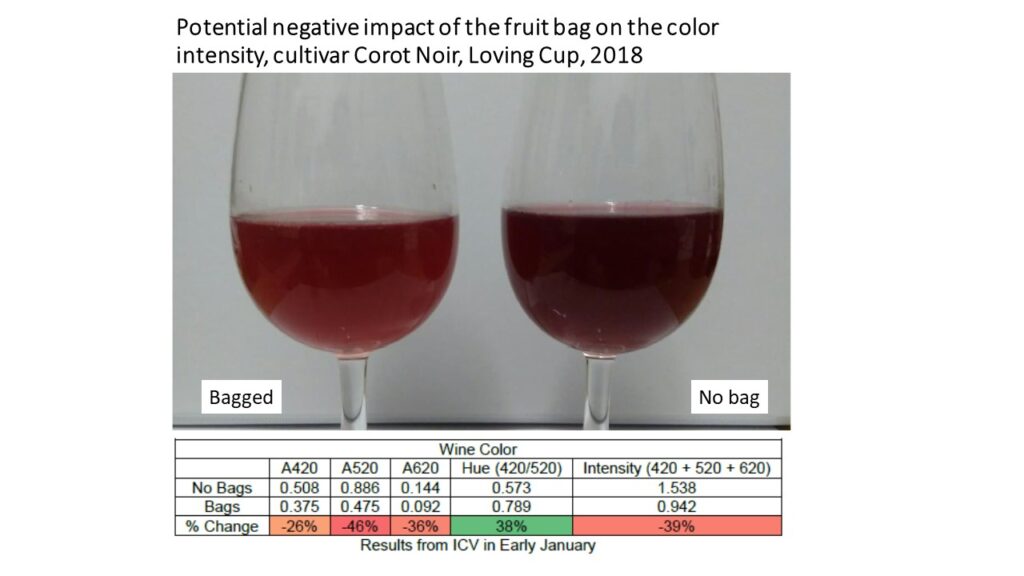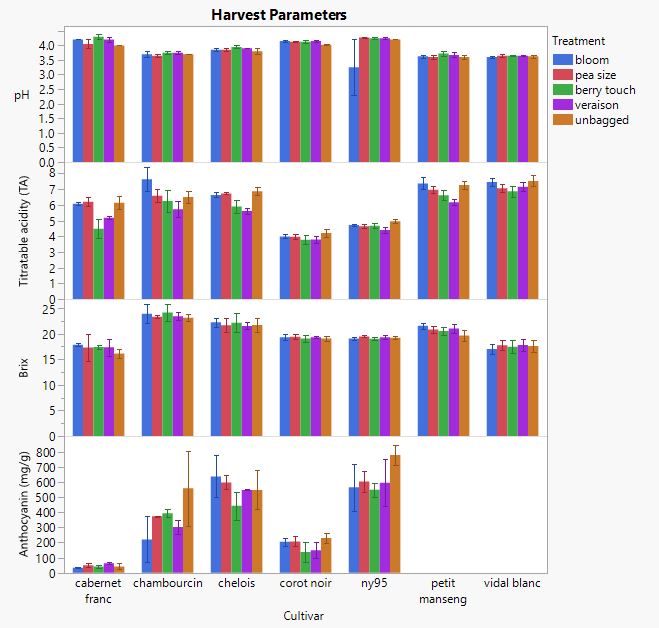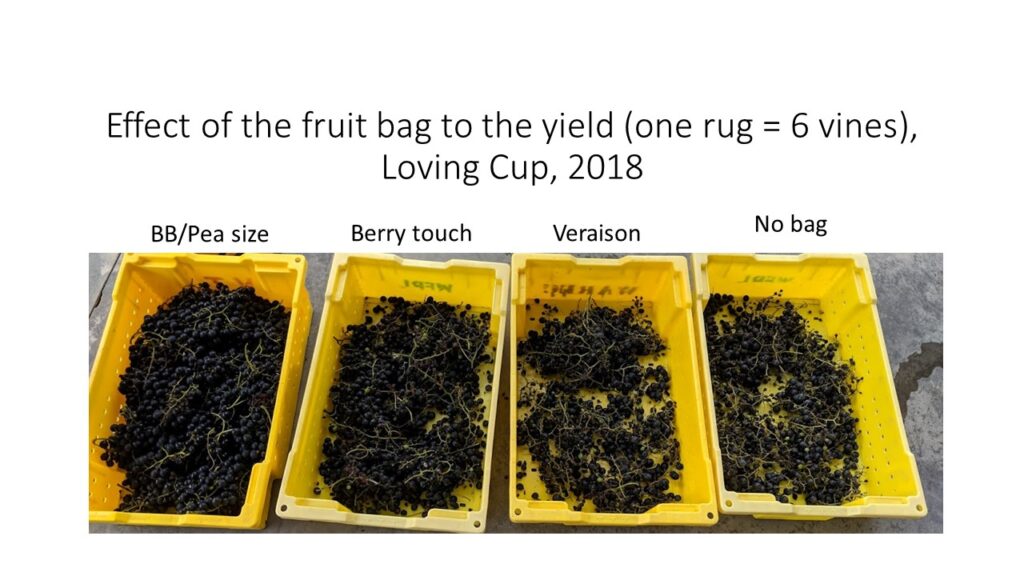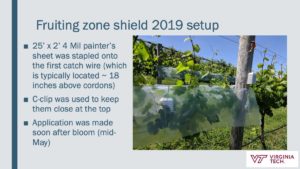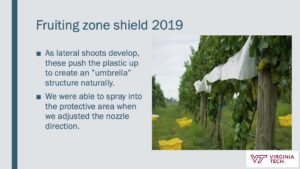Final report for OS17-107
Project Information
The recent economic impact study on the VA wine industry showed an annual contribution of $1.3 billion dollars to the state’s economy. The total acreage of certified organic grape production has increased from 12,575 acres in 1995 to 38,664 acres in 2011. However, only three Virginia vineyards have been approved by the USDA for their organic management practices for wine grape production, and only one has a winery. The main reason why organic wine grape production is not common in VA or any other states located the east of Rockies is fungal diseases, which are driven by frequent rain events during summer months. Thus, the Nita lab has established two experimental vineyards with financial aid from the USDA/NIFA VDACS Specialty Crop Research Initiative Block Grant in 2012. Although we identified several cultivars that may do well with the organic practice, there are two big challenges: a disease called black rot, which none of the OMRI-certified chemicals works sufficiently, and a potential loss of copper fungicides due to a trend of tighter regulations in other countries. Rather than searching for other chemical components, which is usually in the hands of chemical companies, what we proposed is the use of paper bags or umbrellas to individually protect grape clusters. The experiments were conducted in two experimental vineyards in AHS AREC, Winchester, VA, and a commercial vineyard in North Garden, VA in 2017 and 2018. We found that the application of the fruit bag can reduce the incidence and severity of black rot up to 90% when it was applied around when grape berries are less than 1 cm in diameter. In addition, we found a combination of a biological control agent Double Nickel and a polyoxin-D, both are approved by the OMRI, are effective, especially when we used them with the fruit bag. Results from our study will help organic wine grape growers to have alternative tools to increase their sustainability.
- Determine the efficacy of paper bags and umbrellas against the development of multiple fungal diseases on wine grape cluster grown with organic practices
- Determine the timing of bagging/umbrella application for the optimal disease control
- Examine the efficacy of different paper bags
- Examine the economic benefits and hurdles of using the individual cluster protection method.
Cooperators
Research
Background
The basic idea here is to provide a physical barrier to prevent the wetting of clusters, which is the condition for many fungal disease developments. In some countries, grapes are grown under a cover (Fig. 2), but at a high cost. Assuming it is similar to building a simple frame high tunnel, it will be approximately $1.50-$2.50 per square foot [7]. Even if we cover only 1/3 of the area where grape canopy occupies, the cost will be $27,780 - $36,360 per acre (acre = 43,560 sq ft). An acre of wine grape yield 3-5 tons of fruit, and a ton of fruit ranges from $1,000-$3,500 [8], thus, each year, the revenue will be $3,000 to $17,500 per acre, but the price of high yielding cultivars is more likely to be at a lower end of the price range, thus, the revenue of $17,500 is very unrealistic. Unless you have a highly productive vine that can be sold at a high price, another capital investment may not be feasible. Plus, we lack information on how these over-the-trellis umbrellas can actually reduce wetting of clusters, or the adverse effects due to the lack of light penetration to the canopy.
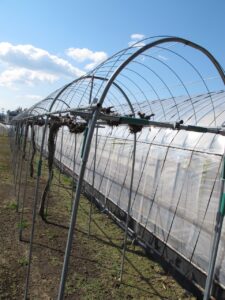
Therefore, our proposed approach is the use of paper bags (Fig. 3) or umbrellas (Fig. 4) to individually protect grape clusters. These bags and umbrellas are made out of water-resistant paper, designed to fit grape cluster, easily applicable with an embedded wire, with small holes for ventilation and water drain, and expected to last for a whole season (Hosino Inc., Niigata, Japan). (Note: light exposure to the cluster is not required for berry maturity [9].) The bagging practice most likely reduces the number of fungicide and insecticide applications because once bagged, clusters are protected from water and insects. Although the application will be very labor-intensive, a conversation with our farmer cooperator (and the only certified organic winery owner and grower in VA), Mr. Hambsch, revealed that he sends out his crew of two only to remove diseased leaves and clusters during the critical times of black rot infection, which is three- to the four-week period after bloom. This accounts for $1,664 per acre per season (2 people x 8 hr per day x 2 day x 4 pass x $13 per hour wage). Thus, even without the bag, they are already spending a lot of time and resources to the point that it will affect their profitability. With this intensity of disease management, bagging of clusters will not only reduce the labor cost but also reduce soil compactions and CO2 emissions that are associated with traffics in the vineyards. Typically, the cost of a bag is around 1-3 cents, and our current estimate of the cost for time to apply bags is about 2 cents per cluster. I.e., with 3-5 cents per cluster, we can produce wine grape organically while reducing pesticide usages.
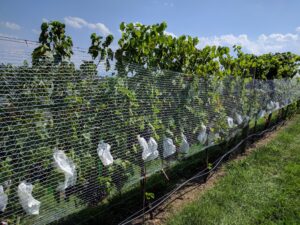
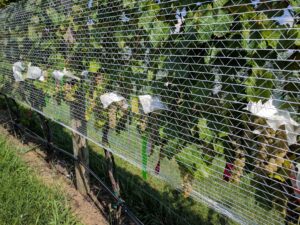
Approach and Methods
Field experiments were conducted at two locations 1) Organic experimental vineyard at AHS Jr. AREC, Virginia Tech, Winchester, VA (hereafter referred to as AHS AREC vineyard), and 2) Loving cup vineyards, North Garden, VA.
At AHS AREC vineyard, a section of the organic experimental vineyard which consists of four cultivars (‘Arandell’, ‘Corot Noir’, ‘Petit Manseng’, and ‘Vidal blanc’) was used. These vines were planted in 2012 and trained in a cane-pruned vertical shoot positioning system (VSP). Vine spacing within a row is 4 ft and between rows is 9 ft. The vineyard consists of four rows, and each row contains four replications of each cultivar, which are planted in triplicate (i.e., three consecutive vines of the same cultivar). In between each replication (or block within a row), there are three vines of Arandell to provide buffer space.
The experimental design was a split-plot design where each row will be considered as the main plot, and a set of cultivar will be considered as a sub-plot.
The main plot factors are:
- Copper Octanoate (Cueva, Certis USA): Cu + bag
- Cu + umbrella
- A biological control agent Double Nickel (Bacillus amyloliquefaciens strain D747, Certis USA) plus Oso (Polyoxin-D, Certis USA): DN + Oso) + bag
- Reduced input conventional fungicides + bag.
At the sub-plot level, there will be five treatments:
- Cover at bloom
- Cover at BB/pea-size (when berries are approximately 5 to 10 mm)
- Cover at bunch closure (when berries touch each other)
- Cover at veraison
- Unbagged control
Each treatment was assigned randomly within each cultivar. Three clusters per vine (= nine clusters per sub-plot) received each treatment, thus, a total of 36 clusters received the same combination of the main and sub-plot treatment. All fungicide applications were made with 14-day intervals, with an exception of one additional application at bloom. This typically resulted in 11 applications per year. For more details on fungicide treatments and the timing of bagging, please refer to the table below.
At Loving Cup vineyards, four rows of a cultivar ‘Corot Noir’ was used for the experiments. The experimental design was a randomized complete block design. Each row of 60 vines was considered as a block, and within a block, there will be four subplots of 15 consecutive vines that received treatments: 1) No cover; 2) Cover at pea-size; 3) Cover at bunch closure; and 4) Cover at veraison, which were assigned randomly to subplots. This larger-scale experiment allowed us to record the time required for the application to determine the true cost of the application. I.e., we were able to estimate the time required to place these bags in a filed setting. Twenty clusters per sub-plot were randomly sampled (= 80 total clusters per treatment) for the assessment at harvest.
These experiments were conducted in two seasons to validate the repeatability of the treatments. Assessments were made at the time of harvest, and we will measure disease incidence (yes/no) and severity (% area infected), insect/animal damage (feeding, etc), average cluster weight and size, and average berry size and weight based on 100 random samples. We assessed for black rot, Botrytis gray mold, downy mildew, powdery mildew, Phomopsis fruit rot, ripe rot, sour rot, and other rots. Additionally, a pool of 100 random berries was sent out to VT’s enology lab for juice quality. Brix (% soluble sugar), pH, titratable acidity, and color profile (Anthocyanin) were measured.
Also, a small temperature/relative humidity sensor with a data logger [12] will be placed in one of bags to monitor changes in temperature in the bag.
The second experiment is to examine the efficacy of different types of fruit bags. We tested six different types of bags in 2018 at AHS AREC. The cultivar was Cabernet Sauvignon planted in 2015. The experiment was a completely random design where five bags of each type were placed on a cluster at pea-size per panel of five vines, and there were five panels. Disease severity of Botrytis gray mold, ripe rot, and sour rot was measured at harvest. The bags tested are:
- #19 (= regular fruit bag),
- S2 (thin experimental bag),
- S3 (very thin bag designed for greenhouse production),
- Green (used to table grape production),
- Clear perforated bag,
- Waxed (no thickness information, but the texture was similar to that of S2), and
- Non-bagged control.
Disease severity, feeding, cluster, berry, and environmental data will be analyzed using a linear mixed model (JMP Pro ver. 15, SAS Institute, Cary, NC) to determine the effect of treatments.
Objectives 1 and 2
Loving cup: Black rot was the major disease that developed in the 2017 season. At Loving cup location, we found both the proportion and disease severity of clusters with black rot were found to be significantly affected (P < 0.05) by the bagging practice, and the degree of the reduction of black rot also depended on the timing of bag application.
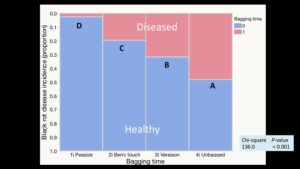
We found significantly lower the proportion of grape cluster with black rot when we applied the bag at pea-sized berry, and the proportion increased as the timing of bagging moves away from the fruit set (i.e., bagged later).
The trend was very similar when we examined the disease severity (% of area diseased).
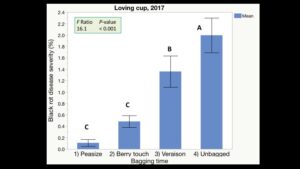
We found a significant effect of bagging on the severity of black rot on the grape clusters. Although it was numerically lower, application at pea-size and berry touch did not significantly differ (P > 0.05) from each other.
The 2018 season was considerably wetter than 2017, and it resulted in higher black rot disease incidence and severity. We also found a significant effect of bagging timing on ripe rot.
As in 2017, the earlier bagging time (at pea-size) resulted in significantly lower black rot incidence and severity. However, probably due to favorable environmental conditions, we observed 100% black rot incidence when the clusters were not protected with fruit bags after pea-size.
With ripe rot, both mean disease incidence and severity were nearly zero when fruit bags were placed at pea-size, and when bags were placed at berry touch, it resulted in a significantly higher disease incidence and severity than other timings. Unlike black rot, ripe rot resulted in significantly lower disease incidence and severity when bags were placed at version and not placed. However, it is most likely due to the fact that black rot incidence and severity were so high because ripe rot pathogens are known to cause cluster infection on maturing grape berries. I.e., available healthy tissue for ripe rot to cause infection was limited.
AHS AREC. We examined three factors, cultivar, fungicide, and bagging timing, and measured mean cluster disease severity of black rot, Botrytis gray mold, downy mildew, powdery mildew, ripe rot, and sour rot. In this report, I am presenting results of black rot and powdery mildew since both are predominant disease in both 2017 and 2018.
Black rot. Mean cluster disease severity per treatment ranged from 0% to 5.5% in 2017. Although there are numerical differences among bagging timings, bagging timing was significant with only one case, which was Petit Manseng which was sprayed with a fixed copper throughout the season. Non-bagged treatment resulted in a significantly higher mean than all bagged treatment, except berry touch treatment.
Mean cluster disease severity per treatment ranged from 0% to 81% in 2018. With the conventional treatment, we did not observe black rot severity higher than 5%; however, with fixed copper (Cu) treatments, the mean cluster disease severity was as high as 81%. Double Nickel and Oso (DN + OSO) treatment resulted in somewhere between the conventional and Cu treatment, indicating that with some cultivar and bagging timing, the combination of Double Nickel and Oso can be a tool for black rot management. In general, earlier bagging timing resulted in lower disease severity, especially when the bag was placed either at bloom or BB/Pea-size. However, the effect of bagging was not effective after berry touch.
Powdery mildew. Mean cluster disease severity per treatment ranged from 0% to 86% in 2017. In general Umbrella treatment did not provide any reduction regardless of the application timing. Although clusters are exposed for fungicide application, some cultivars (e.g., Corot Noir and Petit Manseng) resulted in very high percentages of powdery mildew. Our speculation on the lack of efficacy is the shade provided by the umbrella probably promoted the growth of the powdery mildew pathogen. When the bag was used to exclude clusters from powdery mildew pathogen, it seemed to provide good efficacy. For example, with both Cu and DN + Oso treatment, application of the fruit bag provided a significant reduction of powdery mildew, compared with non-bagged treatment.
Mean cluster disease severity per treatment ranged from 0% to 67% in 2018. In general Umbrella treatment did not provide any reduction regardless of the application timing, as in 2017. In contrast to 2017, when the fruit bag was applied at bloom, it resulted in higher powdery mildew severity than other timings. We speculate that it happened because the availability of powdery mildew pathogen’s spore was high at the bloom, and by placing the fruit bag, we might have trapped spores with the cluster.
The temperature in the fruit bag.
We placed a temperature probe in the fruit bag to measure the change in temperature within the bag. The sensors are placed in a fruit bag facing south (sun) and north (shade), and also the ambient temperature was measured.
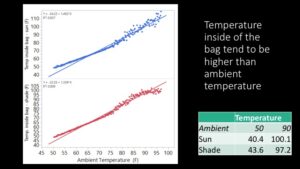
As we expected, the temperature inside of a fruit bag tended to be higher when the ambient temperature was high and the temperature also depended on where the cluster was located. For example, at the ambient temperature of 90F, the temperature inside of the bag at the shaded cluster was 97F and at the sun-exposed cluster was 100F. On the other hand, when the ambient temperature was low, the temperature inside of the bag tended to be lower. For instance, when the ambient temperature was 50F, the temperature inside of the bag was in lower 40F. This is a reflection of the temperature during the night. The air inside the bag was cooled down during the night and took a long time to be warm up when the sun comes up (Fig. below). We did not see any noticeable difference between bagged and unbagged clusters in terms of heat-related damages (burning of berries, etc.).
Objective 3: Type of bags. The effect of bag type was significant on the mean disease severity of Botrytis, ripe rot, and sour rot.
Botrytis: The mean cluster severity ranged from 4% to 39%. S3 (= very thin) bag was not significantly different from exposed (non-bagged) clusters; #19, Clear, and Green resulted in good control; however, there are cases where clusters in the clear bag were covered with Botrytis.
Ripe rot: Clear bag resulted in the highest severity. This was not surprising since ripe rot pathogens can infect flowers and thrives under warm conditions.
Sour rot: All bags hold well, although there are some bad clusters, especially with the regular #19 bags.
Despite the frequent rains, we observed in 2018, all bags, including S2 and S3 thin bags held very well. Where we found the failure in Botrytis and sour rot protection was when the bags were not installed correctly. These fruit bags have a wire that is designed to be wrapped around the rachis or the shoot to which the cluster is attached. However, with a batch of clusters, which was installed by the same individual, the wire was not secured well. At the time of harvest, we observed that many of these bags with the loose end were wet inside. When we divided the dataset into damaged/loose end bags and properly installed bag, there was a significant difference in both Botrytis and sour rot cluster severity (fig. below).
Objective 4: The time required to install fruit bags. We measured time required for bagging in 2017 at Loving Cup where we had more than 1,000 bags to be placed at each bagging timing. Bags were placed by four people who did not have any experience prior to the experiment. At pea size (June 14), it took 2 hours and 48 min (9:46AM to 12:34AM) to place 1,300 bags (or ~ 1.9 bags/min/person). At berry touch (July 5), it took 1 hour and 46 min (9:25AM to 11:15AM) to place 1,173 bags (~ 2.7 bags/min/person) At veraison (July 27), it took 2 hours (9:32AM to 11:32AM) to place 1,230 bags (2.6 bags/min/person). On average, each worker was able to place 2.6 bags per min.
Harvest parameters
One of the concerns with the fruit bag was the reduced intensity of red color, especially with red-fruited cultivars. At Loving cup, we observed a notable reduction in color in fruits in the field.
In 2017, we measured the red color intensity by combining absorbance at 420 nm and 520 nm. Although there are some numerical differences, there was no significant difference observed among different bagging timing and non-bagged clusters (Table below).
In 2018, we measured the total anthocyanin content in mg/L. As in the results from the 2017, the bagging effect was not significant (Table below).
In 2017, we made a small batch of wine at Loving Cup, the color difference was notable, and the difference was also shown in the red color intensity (Fig. below). We submit several samples for an unofficial sensory test where raters also noticed the difference in color; however, results from the blind test did not indicate a strong preference by the raters.
We were not certain what caused this extreme difference in colors between berries harvested at the AREC and Loving Cup. The cultivar Corot Noir was examined at both locations. One potential speculation is that the manufactures of bags. Due to the number of bags required at Loving Cup, we purchased bags from a Chinese company, while at the AHS AREC, we used ones from either Hoshino or Kobayashi Seitai, both are Japanese companies who have their own factories in Japan.
We also measured Brix (soluble sugar content), pH, and TA (titratable acid). In both 2017 and 2018, there was no significant treatment effect. The results from 2018 are shown below as a bar graph (below) and also as an ANOVA table shown above.
Summary
- Fruit bags can reduce black rot by 90% when we apply them at BB/pea-size (berry diameter is less than 1 cm).
- We were able to reproduce the results at two different locations in two years.
- In almost all cases, protection at bloom was more effective.
- But it can be less practical because of the difficulty of installing the bags.
- The umbrella did not provide adequate protection
- With the bagging, powdery mildew can be an issue.
- Treatment of Double Nickel plus Oso was effective against both black rot and powdery mildew.
- Different types of bags were also tested and shown to be effective.
- Failure was associated with the lack of proper installment of the bags.
- The use of fruit bags can reduce the anthocyanin production on berry skins, but the results were inconclusive.
- A worker can place ~ 2.6 bags per min, with minimum training.
Educational & Outreach Activities
Participation Summary:
Oral presentations at professional meetings
Nita, M. Nahiyan, A., and Lee, J. (2019) 'Wine Grape Field Trials (BioSafe, PlantAid, Helena, and protective shield) at Winchester, VA, 2019.', Cumberland-Shenandoah Fruit Workers Conference, Winchester, VA, 12/06/19, Oral
Nita, M. and Oliver, C. (2018) 'Field trial updates 2018: Botrytis gray mold on grapes and bagging trials.', Cumberland-Shenandoah Fruit Workers Conference, Winchester, VA, 11/30/18, Oral
Nita, M. (2017) 'Use of Fruit bags to manage grape diseases in Virginia Vineyards', Cumberland-Shenandoah Fruit Workers Conference, Winchester, VA, 12/01/17, Oral
Extension presentations
Nita, M (2019) Results from bagged cluster experiments, Virginia Wine Research Exchange, Leesburg, VA, 03/13/2019, Oral
Nita, M (2018) Grape Pathology Field Trials, VT Field Day, Winchester, VA, 09/11/2018, Tour
Extension workshops/field day
Nita, M (2018) Use of fruit bags for grape disease management, Grape Pathology Field Day, Winchester, VA, 09/05/2018, Oral
Newsletter article
Nita, M (2018) Trying Out Bags on Berries, Grape Press, Virginia Vineyard Association
Learning Outcomes
Importance of protection of grape clusters against pathogens
Project Outcomes
The baseline question we had at the beginning of the project was "Can we make organic grape production sustainable under Virginia's environmental condition using the fruit bag practice?" I believe our answer is "Yes, it can." We demonstrated that the use of fruit bags can reduce a disease called black rot, which is the major bottleneck for organic grape production due to the lack of effective fungicides and resistant cultivars. By protecting berries at pea-size when berries are about 0.5 to 1 cm in diameter, we successfully reduced the incidence and severity of black rot up to 90%. We were able to reproduce the results at two different locations in two years.
The three pillars of sustainable agriculture are environment, economy, and social (common ones used in different disciplines) and/or profit, stewardship, and quality of life (proposed by SARE) [10]. VDACS ranks grapes as the 18th most profitable commodity in Virginia in 2014 [11], a total of $740 million annual economic impacts by the VA wine industry was reported in 2011 [3], and more than 300 wineries exist throughout the commonwealth in 2020. Although the upward trend may continue for a while, we need to think ahead and come up with strategies to help the sustainability of vineyard operations and winery businesses, which are the backbone of our industry. The increased profitability with organic production can be achieved by potentially higher price tags accepted by target consumers, and/or by avoiding potential loss of market share by apt to the increased demands for organic certified options [4].
The use of fruit bag examined in this project reduces unnecessary environmental outputs while increasing profit margins by reducing the use of insecticides and fungicides, which covers both profit and environmental stewardship. It touches the quality of life because people living within proximity of vineyards will benefit from reduced fungicide drifts. Additional profitability potentially achieved by the covers are: bird and animal protection (no need for bird netting or squirrel and raccoon hunting), less need for leaf pulling (very common and time consuming practice), potentially no needs for deer fencing (another expensive capital investment and aesthetically not pleasing), and increase in yield and quality (Fig. below). Since the fruit bag is a compostable paper material to reduce pesticide usage, probably face less oppositions from citizen and government entities than traditionally farmed operations, thus, it will help the improvement of neighbor and community relations [2]. The use of environmentally sound practice most likely can be used as a marketing tool to attract more customers to the winery. “Handcrafted wines from individually bagged clusters for low pesticide usage” should appeal to wide range of customer groups.
Fig. above. In 2018, we experienced more rainfall during the season than a typical year, which resulted in outbreaks of black rot in the organic vineyards. The fruit bag provided excellent protection against black rot, and thus, was able to secure crops.
This study generated new integrated pest management tools for sustainable viticulture in Virginia that will further help the industry expand and provide more revenue for vineyard owners and the state of Virginia. We do not envision every cluster in VA vineyards to be covered, but growers most likely to implement this for high-value cultivars that can earn a premium price. Based on the success of our results, we were able to obtain a grant to test the fruit bags with table grapes, which is probably more suitable for the practice. The project will start in 2021.
We also realized that wine grape growers are hesitant to apply this technic because of the labor cost. Given the success of this project, we have initiated a new project where we use a different type of protective material. We are experimenting with two types of rain shields that are installed to protect the entire fruiting zone of the grape canopy (Fig. below). So far, we found that the majority of diseases that require rain for infection can be reduced significantly, and we are hoping to expand upon the initial study to examine different application timings and materials.
Lastly, we proposed to utilize the covers in organic wine grape production because this approach seems to fit better with organic practices; however, it can be adapted to conventional grape growing methods. In fact, with the availability of systemic fungicides and insecticides, it may appeal better to conventional growers who want to drastically reduce the use of fungicides and insecticides. Due to its simplicity, the cover can be used on vineyards in other states in the South (which is also increasing in numbers) as well.
Information Products
- Use of fruit bags to manage grape diseases in Virginia vineyards. (Conference/Presentation Material, Conference Proceeding)
